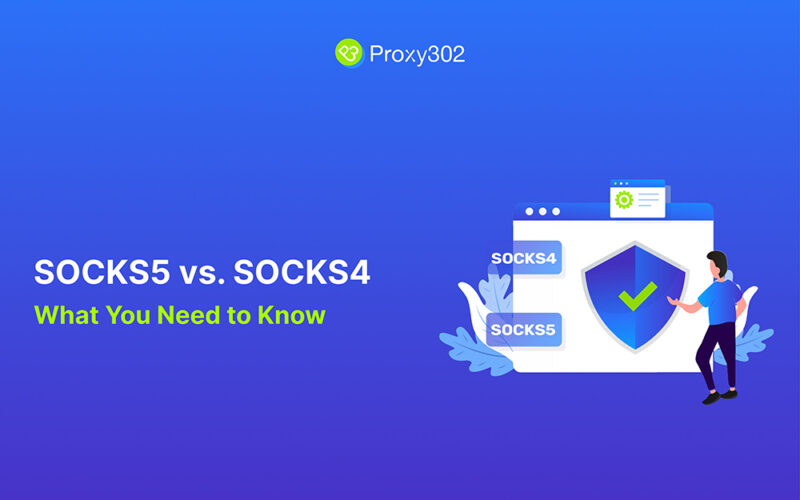When it comes to proxy protocols, SOCKS5 and SOCKS4 are two of the most commonly used options. While they share some similarities, they also have key differences that make them suitable for different use cases. In this article, we’ll break down the features, capabilities, and limitations of SOCKS5 and SOCKS4 to help you choose the right protocol for your needs.
What Are SOCKS Proxies?

SOCKS (Socket Secure) is a protocol that routes network traffic between a client and a server through a proxy server. It’s widely used for tasks like bypassing geo-restrictions, enhancing anonymity, and improving security. SOCKS proxies are particularly popular because they can handle various types of traffic, including HTTP, HTTPS, and FTP.
Key Differences Between SOCKS5 and SOCKS4
While both SOCKS5 and SOCKS4 serve the same basic purpose, they differ in several important ways. Here’s a detailed comparison:

1. Protocol Support
- SOCKS4: Only supports TCP (Transmission Control Protocol), which is used for reliable, connection-oriented communication.
- SOCKS5: Supports both TCP and UDP (User Datagram Protocol), making it more versatile for applications like video streaming, online gaming, and VoIP,
2. Authentication
- SOCKS4: Does not support authentication, meaning anyone can use the proxy without verifying their identity.
- SOCKS5: Includes authentication mechanisms, such as username/password verification, which adds an extra layer of security.
3. IP Address Support
- SOCKS4: Only supports IPv4 addresses, which are the traditional 32-bit addresses.
- SOCKS5: Supports both IPv4 and IPv6 addresses, making it future-proof and compatible with modern networks.
4. DNS Resolution
- SOCKS4: Does not support DNS resolution, meaning the client must resolve domain names before connecting to the proxy.
- SOCKS5: Can handle DNS resolution on the server side, simplifying the process for the client.
When to Use SOCKS4
SOCKS4 is a good choice for simple, low-security tasks that only require TCP support. For example:
- Web Browsing: Accessing websites that don’t require high security.
- Basic Data Transfer: Sending files or data over a reliable connection.
However, its lack of authentication and UDP support makes it less suitable for high-security or real-time applications.
When to Use SOCKS5
SOCKS5 is the more advanced and versatile option, ideal for:
- Streaming and Gaming: Its UDP support ensures smooth performance for real-time applications.
- Secure Browsing: Authentication mechanisms protect against unauthorized access.
- Modern Networks: IPv6 support ensures compatibility with the latest internet infrastructure.
Practical Use Cases
1. Bypassing Geo-Restrictions
Both SOCKS4 and SOCKS5 can help you access geo-restricted content, but SOCKS5’s DNS resolution makes it more efficient.
2. Enhancing Anonymity
SOCKS5’s authentication and IPv6 support provide better anonymity and security, especially for sensitive tasks.
3. Improving Performance
For applications like video streaming or online gaming, SOCKS5’s UDP support ensures faster and more reliable performance.
Conclusion: Which One Should You Choose?
The choice between SOCKS5 and SOCKS4 depends on your specific needs:
- Choose SOCKS4 if you’re looking for a simple, lightweight solution for basic tasks.
- Choose SOCKS5 if you need advanced features like authentication, UDP support, and IPv6 compatibility.
In most cases, SOCKS5 is the better option due to its versatility and enhanced security. However, if you’re working with legacy systems or don’t need the extra features, SOCKS4 can still get the job done.
Ready to try SOCKS proxies? Whether you’re a beginner or an advanced user, understanding the differences between SOCKS5 and SOCKS4 can help you make the most of your proxy experience. Tools like Proxy302 provide an additional layer of protection, ensuring your data remains safe in an increasingly interconnected digital world.
👉 Start Your Free Trial Now 👈and unlock a world without digital borders.









1 comment
The comparison between TCP and UDP support really helped clarify why SOCKS5 is more suitable for real-time applications like gaming or VoIP. It’s interesting how the addition of UDP opens up so many use cases beyond what SOCKS4 can handle.